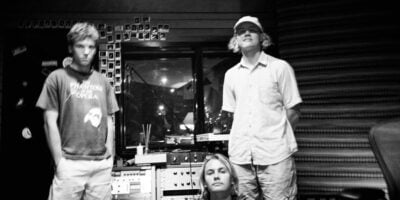Hurray For The Riff Raff frontwoman Alynda Segarra is a proud Nuyorican woman, an identity claimed by many Puerto Rican descendants living in and around New York. The city hosts the largest population of Puerto Ricans outside of the Caribbean island, and growing up in the Bronx, Segarra would often dwell in the Nuyorican Poets Café, listening to Latin poetry slams. She felt isolated: she wasn’t considered white enough for the white kids, nor Puerto Rican enough for her peers.
“For me, being a child of the diaspora means that I am in the middle, and being in the middle means you’re a bridge,” she says. “It means that you can never fully experience your homeland, but you still have it inside you. And with that comes a really big responsibility – to honour Puerto Rico.”
Connecting with her heritage has been a long journey, which is captured in her latest album, The Navigator, a time-travelling two-part narrative. “The album is meant to be a play that I would love to one day write, with the music accompanying the storyline,” she says. “Nivita is a 17-year-old street kid; a really tough Puerto Rican girl [in a] city that could be any big city in any part of the world.”
The first half sees Navita rejecting her ancestry: “She wants to wake up and not recognise anyone around her because she is so ashamed of where she comes from,” says Segarra. “She feels so constricted in society. She just wants to be free and kind of get rid of her roots, which is [how I felt] when I ran away when I was 17.”
The album starts with soulful refrains in ‘Entrance’, chords that sound like they were recorded in a New York subway. Men sing “two for the train that’s rolling, get on board”, an invitation to join the journey with Segarra, who spent time train-hopping across America when she was 18. “I was wondering the country with no money, sleeping outside and sleeping under bridges, and I was treated like shit – I was just a kid.”
‘Living In The City’ starts us off with light and warm Americana; Navita shrugs off casual harassment while detailing caricatures of the lives she passes. “I was just so naïve and so in love with city people … People who lived on the outskirts and the underground; people who just survived somehow. In reality it seems like so many people shouldn’t survive. They’re homeless, they don’t have any money, no one respects them … the part of gentrification that I hope to talk to my generation about is that dehumanising aspect.” She asks us to see the homeless and the displaced as “worriers and survivors”.
In ‘Hungry Ghost’ Navita moves away from this imagined city: “I’ve been a lonely girl, but I’m ready for the world”. Afro-American drums and brass instruments enter the soundscape in ‘Nothing’s Gonna Change That Girl’ and violins being to swirl; the beginning of a cultural shift in the album.
Although perfectly realised in The Navigator, it’s taken Segarra three full-length albums for her to begin addressing her lineage. “I was invited to go to a writer’s retreat with an organisation called Hedgebrooke. I was able to go and really be in the woods for a week and write and be around other women artists, and that was a really important time for me,” she says.
Here she soaked up her history with Latinx-centric documentaries like Searching For Sugarman, taking a step back from the traditional blues she’d been focusing on. “Creating kind of a concept album like Ziggy Stardust, it just freed me. I felt like I could talk about whatever I wanted and I felt like my character was allowed to talk about these things.
I think it’s a really hard part of resistance and work that people of colour did, watching that get co-opted into something else.
“The next part of the album, Rican Beach… it’s 40 years [later], and it becomes so gentrified that she doesn’t recognise anything,” says Segarra of the place the record moves. “What’s so hard about going back to New York is watching stuff get erased or co-opted. I think it’s a really hard part of resistance and work that people of colour did, watching that get co-opted into something else, that’s just to be sold in like a package – a lot of it feels very maddening.
“You go to Harlem and like, Harlem’s different. There are murals on the walls, but like, it’s for a fancy hotel … it feels kind of like you’re going crazy. And so that’s what I really wanted to do with this album. I wanted to be like, you’re not crazy if you see this – this is happening.”
On the day of this particular phone call, she mentions that Donald Trump has re-tweeted anti-Muslim propaganda via “white supremacist groups”, AKA the British National Party. “It’s just another busy news day in America,” she says. “Our country is constantly defending its madness.”
It feels hard to imagine that it’s only been a year since Segarra released The Navigator, singing lyrics like, “Politicans run their run their mouths, you say you’ll build a wall to keep them out” and “Poets dying of a silence disease” on ‘Rican Beach’.
When we discuss the poor living conditions on Manus Island and the rejection of asylum seekers to Australia, Segarra says, “More and more I feel like we are forgetting that borders are so often manmade.” It reminds me of lines Tim Harford wrote in the 2017 book, 50 Things That Made The Modern Economy: “The concept of passport as protection goes back to biblical times… [Passports] were, essentially, a threat: a letter from some powerful person requesting anyone the traveller met to let them pass unmolested.”
It just takes a war that you had nothing to do with to put you in these people’s shoes.
At the turn of the 20th century it was thought that passports might cease to exist altogether, but World War I reinforced the perceived need for border control. We live in a time where the geographic location of your birth (not to mention your race) determines your rights and your worth – that is, unless you have a spare $150,000 US dollars: then you can purchase “citizenship by investment”.
“We’re losing our empathy for people who are less fortunate,” Segarra says. “Sadly, it can be us at any day. It just takes one catastrophe. It just takes a war that you had nothing to do with to put you in these people’s shoes.”
To combat such dividing lines, Segarra has started a festival called Nosotros (Spanish for ‘us’), wherein intersectional Latinx music, performance and activism are given space at New York’s Licoln Centre.
For me, being a child of the diaspora means that I am in the middle, and being in the middle means you’re a bridge.
On a personal level, some people of colour that are inspiring Segarra right now are Residente, Princess Nokia, Downtown Boys and Solange. Particularly Solange. “Everybody should listen to Solange all the time,” Segarra says. “I just think that she’s like such a gift to us.”
The Navigator’s most gut-wrenching moment lies in ‘Pa’Lante’. Translated from Latin American and Puerto Rican slang, it’s a contraction of para adelante, meaning ‘forward’. After a recording of Puerto Rican poet Pedro Pietri, Segarra calls to the ghost of Emmett Till and to her family and all those affected by colonisation to move onwards. Some things are better left heard to be felt, and ‘Pa’Lante’ is one of them.
https://www.youtube.com/watch?v=AOL2OkV-TkU
Hurray For The Riff Raff will play the Factory Theatre on Monday March 26 as a Bluesfest sideshow. The Navigator was featured in our 50 best albums of the year; have a look back here.


































